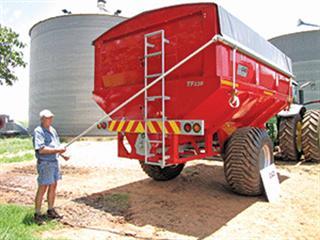ohn and James Jackson, the father-and-son team of Jackson Farming in KwaZulu-Natal’s Bergville district, say the key to productivity lies in keeping machines operating at maximum capacity for as long as possible when planting and harvesting their soya bean and maize crops. The most recent addition to their range of implements is AgricCAD’s 17t TF220 chaser bin, which enables a combine to unload while still harvesting.
This means the operator doesn’t have to work out whether or not there’s enough space in the tank for another round of the land. He can unload when convenient. In addition, the chaser bin can discharge its load into the transport vehicle in less than four minutes. This, believes James, will improve their combine productivity by at least 25%.
From left: AgriCAD’s Charl Fouché with John and James Jackson. This was the 50th bin manufactured by the company.
It also means their JD S660 combine will be able to cope with their harvest. Having to buy the next model in the John Deere range would have cost significantly more than the price of the new chaser bin, adds John. Handing over the trailer was a special occasion for AgriCAD as it was the 50th bin manufactured by the Pretoria-based company since it commenced operations in 2009.
The AgriCAD chaser bin
The AgriCAD chaser bin’s hydraulically operated bottom dump gate enables rapid discharge into a silo receiving pit. The discharge auger has a capacity of around 5t/minute for rapid unloading to a height of 4,1m and the 3m-wide bin makes unloading from the combine easier, minimising spillage.
Bearing in mind large chaser bins are notoriously prone to collision damage, replaceable modular segments, as opposed
to the more usual all-welded construction, make repairs easier and quicker. The TF220 has a 22 000l capacity (approximately 17t) and the TF160 a capacity of 16 000l (12t). Both models have Henred axles and wide flotation tyres.
Covering the load is easy
The AgriCAD chaser bin’s tarpaulin cover can be operated by one person and is a distinct advantage in changeable weather conditons. Here John Jackson shows its ease of use. The bin also comes equipped with a floodlight for night-time operations.
Optimising spraying
John Jackson, who has 380ha under pivot irrigation, optimises the operation of his John Deere 4720 self-propelled crop sprayer (30m boom) with a mixer manufactured by Jerrycar, based in Frankfort in the Free State. Normally employed for aerial spraying, it’s used in conjunction with a 6 000l water cart to rapidly fill the 3 000l JD sprayer.
John Jackson explains to Lungisane Hlongwane how the mixer works.
The mixer, which has a 1 000l/minute pump powered by a small Robin petrol engine, thoroughly mixes up to 750l of spray chemicals using an ingenious manifold that runs the full length of the mixer tank. When the crop sprayer returns for a new load, the mixer refills the sprayer’s 3 000l tank with this 750l, together with 2 250l of water from the cart in a few minutes.
This is normally sufficient for about 40ha, depending on the volume applied, and means that the unit is capable of spraying up to 40ha/hour. The Jerrycar mixer also has a valve system that can swop from filling to emptying. In addition, there’s a nifty device for washing out the chemical containers, ensuring safety.



